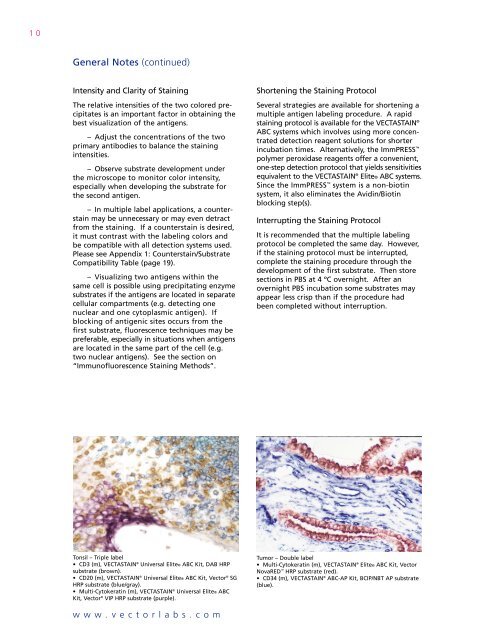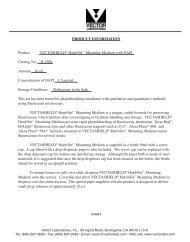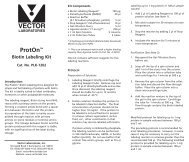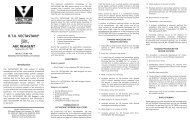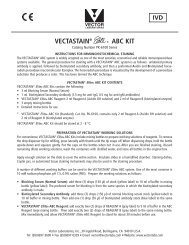Multiple Antigen Labeling - Vector Laboratories
Multiple Antigen Labeling - Vector Laboratories
Multiple Antigen Labeling - Vector Laboratories
- No tags were found...
Create successful ePaper yourself
Turn your PDF publications into a flip-book with our unique Google optimized e-Paper software.
10General Notes (continued)Intensity and Clarity of StainingThe relative intensities of the two colored precipitatesis an important factor in obtaining thebest visualization of the antigens.– Adjust the concentrations of the twoprimary antibodies to balance the stainingintensities.– Observe substrate development underthe microscope to monitor color intensity,especially when developing the substrate forthe second antigen.– In multiple label applications, a counterstainmay be unnecessary or may even detractfrom the staining. If a counterstain is desired,it must contrast with the labeling colors andbe compatible with all detection systems used.Please see Appendix 1: Counterstain/SubstrateCompatibility Table (page 19).– Visualizing two antigens within thesame cell is possible using precipitating enzymesubstrates if the antigens are located in separatecellular compartments (e.g. detecting onenuclear and one cytoplasmic antigen). Ifblocking of antigenic sites occurs from thefirst substrate, fluorescence techniques may bepreferable, especially in situations when antigensare located in the same part of the cell (e.g.two nuclear antigens). See the section on“Immunofluorescence Staining Methods”.Shortening the Staining ProtocolSeveral strategies are available for shortening amultiple antigen labeling procedure. A rapidstaining protocol is available for the VECTASTAIN ®ABC systems which involves using more concentrateddetection reagent solutions for shorterincubation times. Alternatively, the ImmPRESS polymer peroxidase reagents offer a convenient,one-step detection protocol that yields sensitivitiesequivalent to the VECTASTAIN ® Elite® ABC systems.Since the ImmPRESS system is a non-biotinsystem, it also eliminates the Avidin/Biotinblocking step(s).Interrupting the Staining ProtocolIt is recommended that the multiple labelingprotocol be completed the same day. However,if the staining protocol must be interrupted,complete the staining procedure through thedevelopment of the first substrate. Then storesections in PBS at 4 ºC overnight. After anovernight PBS incubation some substrates mayappear less crisp than if the procedure hadbeen completed without interruption.Tonsil – Triple label• CD3 (m), VECTASTAIN ® Universal Elite® ABC Kit, DAB HRPsubstrate (brown).• CD20 (m), VECTASTAIN ® Universal Elite® ABC Kit, <strong>Vector</strong> ® SGHRP substrate (blue/gray).• Multi-Cytokeratin (m), VECTASTAIN ® Universal Elite® ABCKit, <strong>Vector</strong> ® VIP HRP substrate (purple).Tumor – Double label• Multi-Cytokeratin (m), VECTASTAIN ® Elite® ABC Kit, <strong>Vector</strong>NovaRED HRP substrate (red).• CD34 (m), VECTASTAIN ® ABC-AP Kit, BCIP/NBT AP substrate(blue).www.vectorlabs.com


